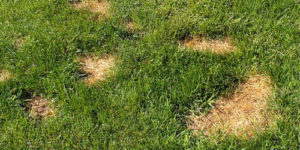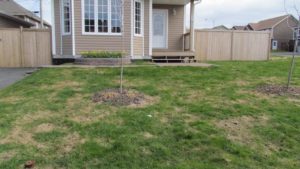Water Wise It ™ – Creating a Water-Wise Lawn!
What’s the best way to fix a brown spots in your lawn?
There are many causes for brown spots, not just under watering. So when you see a brown spot don’t just default to watering your whole lawn. The first thing you should check is if the area has adequate coverage from the sprinklers. If after examination you find that it is from under watering, just drag a hose to the one spot for the best results. If Sprinkler Coverage isn’t the problem some alternative issues can include:
Bugs: There are really only two types of bugs that cause issues with cool season lawns. Billbugs and Cutworms. With both of these insects the larvae do most of the damage. Cutworms leave their damage on both established, and new sods leaving small patches of brown grass usually 1-2 inches wide. The parent cutworms lay their eggs in late summer and the larvae hatch a couple months after, spending the winter in clumps of grass before feeding in the spring and maturing into moths in the early summer. Billbugs on the other hand lay their eggs in the early spring, soon after the grubs are hatched and they move to the crowns and roots of the turf where they eat at the turfgrass and produce a small circular pattern of yellow-brown grass. If the brown spot creeps and you can pull up the blades of brown grass easily revealing bare dirt apply a season long grub control. It is advisable to do this sometime between Mid-April and the end of May.

Pets: It’s a fact of life that animals pee, and if they do it in one specific spot over a period of time the acidity can wither away the grass. Luckily the solution is simple. Simply add one tablespoon of vinegar per gallon of drinking water to decrease the acidity of the urine.

Snow Mold: Snow cold is common in cold weather climates, especially where prolonged snow coverage is present. Snow mold will generally not kill bluegrass but some common-sense practices can be observed to minimize snow mold effects, like gradually lowering the blade of your lawn mower in the late fall, preparing your grass for winter. Another tactic is simply to fertilize your lawn in October to insure that the plants will be healthy throughout the winter. The final tactic is to lift the lawn blades by hand raking or by aerating in the spring as the snow melts off of the lawn.
For more information on how to care for your cool season lawn or on how to Water-Wise It™ refer to the Chanshare lawn Care Guide at www.chanshare.com or email pictures of the trouble spots to sales@chanshare.com.